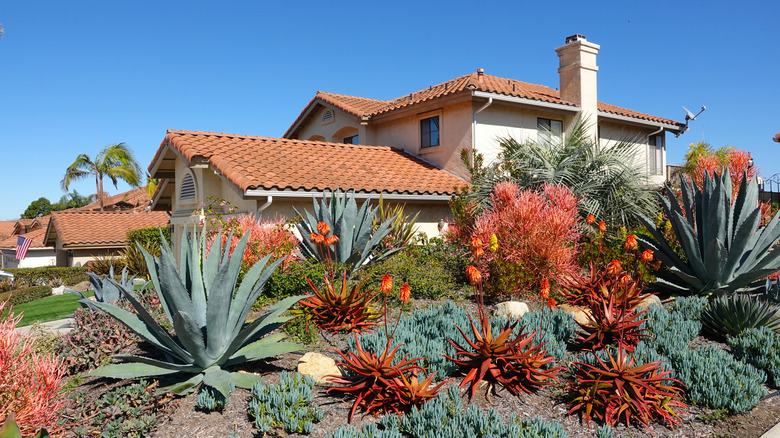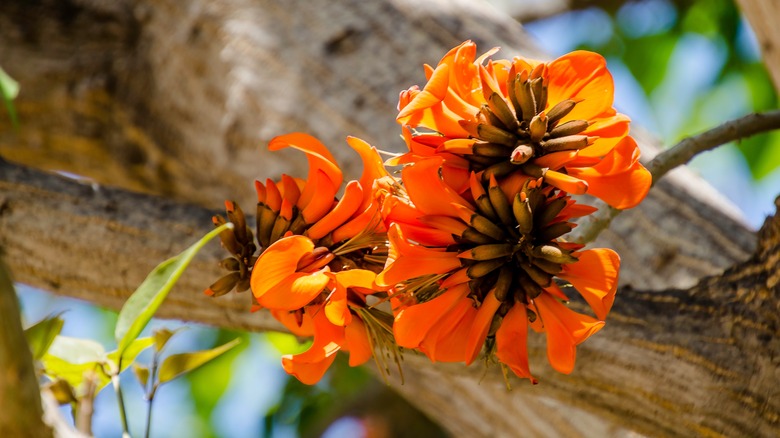The Unique, Drought-Resistant Tree That Can Grow In Some Of The Hottest Environments
If you live in one of America's hot, dry microclimates (looking at you, gardeners of North America's Pacific Coast), you're likely tired of watering perpetually parched properties. Looking for drought-resistant trees to grow in your yard is the way to go, and seeking out a U.S. native option is even better. If you need a huge tree with dramatic blooms that grows up fast and requires little-to-no watering once mature, the wiliwili, endemic to the dryland forests of the Hawaiian islands, has you and your land quite literally covered.
Going by the scientific moniker Erythrina sandwicensis, the wiliwili is in the Fabaceae (pea) family and has a few other common names, including the Hawaiian coral tree and tiger's claw. Where the latter name is inspired by the claw-like blooms, wiliwili comes from the seed pods, which twist to release their bounty. It's not the world's only coral tree — in fact, there are well over 100 species globally. The light wood of the tree, which grows to between 30 and 50 feet tall and 25 feet wide, was once used to make canoes to surfboards. The flowers and seeds are traditionally used in leis. Among its many amazing features, it's one of the only native deciduous trees in Hawaii and can photosynthesize through its bark. The tree is predated on by an introduced gall wasp almost to extinction. However, the controlled release of a natural enemy — another wasp, in fact — has helped reduce gall wasp populations and save the tree.
Why you should plant wiliwili in your garden
Desert and Mediterranean climate gardeners will love the wiliwili's extreme drought, wind, and salt tolerance. It likes and thrives in dry, exposed sites where the sun beats down all day, even when it's just a sapling. Don't plant this tree if you garden anywhere lower than USDA Hardiness Zone 10 since that's the coldest area where this tree is hardy. In other words, if you're cultivating a xeriscape, wiliwili is the tree for you. Aesthetically, the plant has many redeeming features, not least that the typically bright orange (though sometimes also red, salmon, peach, light green, yellow, or white), pea-flower shaped blooms continue to erupt from branch ends from the start of summer right through to the end of November.
It loses its leaves just before flowering, a clever energy conservation adaptation. Some gardeners see this as a downside, while others like the interest the shapes of the gnarled revealed trunk and branches add to a landscape. The leaves grow back after flowering is finished, making the plant a good shade tree for spring and fall. Since it's in the pea family, wiliwili is a nitrogen-fixing tree. It takes nitrogen from the air and redistributes it back into the soil, aiding nearby plants. Hummingbirds love the flowers, too, making it one of the best plants for your pollinator garden Oh, and we just have to mention the trunks of this tree boast an alluring orange tone, as do the largest branches.
Getting and caring for your a wiliwili tree
Scarify wiliwili seeds to improve germination. You can also soak the seeds in hot (not boiling) water, but you might have to wait up to a year for them to sprout. Plant one seed per 3 inch pot. You can also grow the tree from cuttings — try this muffin tin hack that makes plant propagation a breeze. Buy seedlings and seeds from specialist nurseries to ensure you're not sold a coral tree cousin like Erythrina variegata. For example, Future Forests Nursery on Hawaiʻi Island sells Erythrina sandwicensis saplings in band pots (5 inches deep and 2.5 inches square) for $11 each.
It might seem counterintuitive to the home gardener, but choose a spot in your backyard that gets lots of sun, has really poor soil, and has excellent drainage — clay and rock-filled sites are just fine for the wiliwili. The tree might tolerate a little morning or afternoon shade, but that's it. You also don't need to worry about mulching this tree. Wiliwili gets big fast, so plant your sapling at least 20 to 25 feet away from your home or other trees. Water it once or twice a week at the most when it's a seedling; once the tree is fully grown, about a decade later, it likely won't need any water! Outside of the gall wasp, watch out for spider mites, Chinese rose beetles, and powdery mildew. Watch kids and pets don't get any fallen seeds — they're reportedly poisonous.

